tow CITROEN DS5 2016 Owner's Guide
[x] Cancel search | Manufacturer: CITROEN, Model Year: 2016, Model line: DS5, Model: CITROEN DS5 2016Pages: 403, PDF Size: 15.62 MB
Page 206 of 403
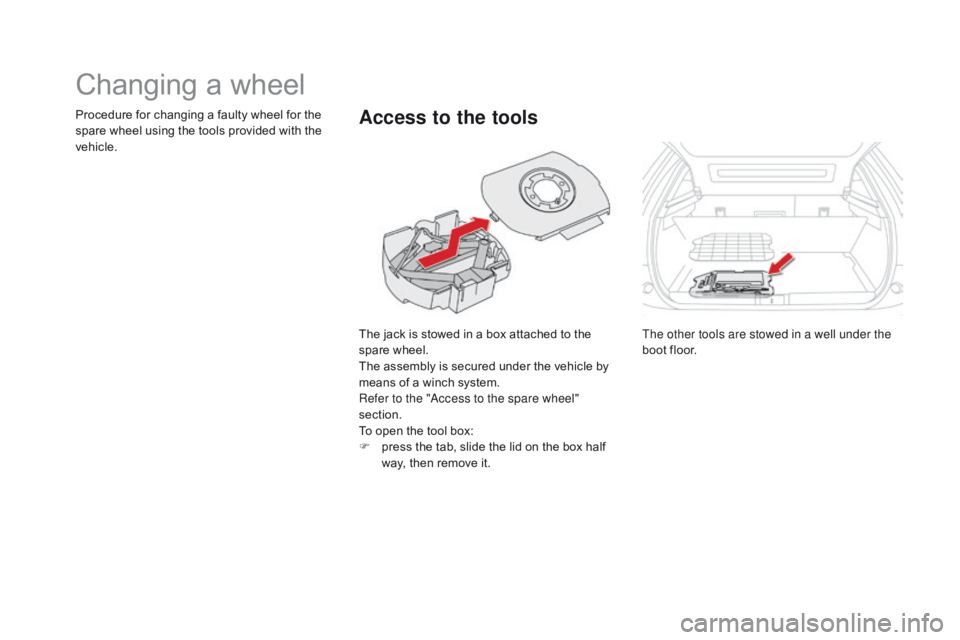
DS5_en_Chap08_info-pratiques_ed01-2015
Changing a wheel
The jack is stowed in a box attached to the
spare wheel.
The assembly is secured under the vehicle by
means of a winch system.
Refer to the "Access to the spare wheel"
section.
To open the tool box:
F
p
ress the tab, slide the lid on the box half
way, then remove it.
Access to the toolsProcedure for changing a faulty wheel for the
spare wheel using the tools provided with the
vehicle.
The other tools are stowed in a well under the
boot floor.
Page 207 of 403
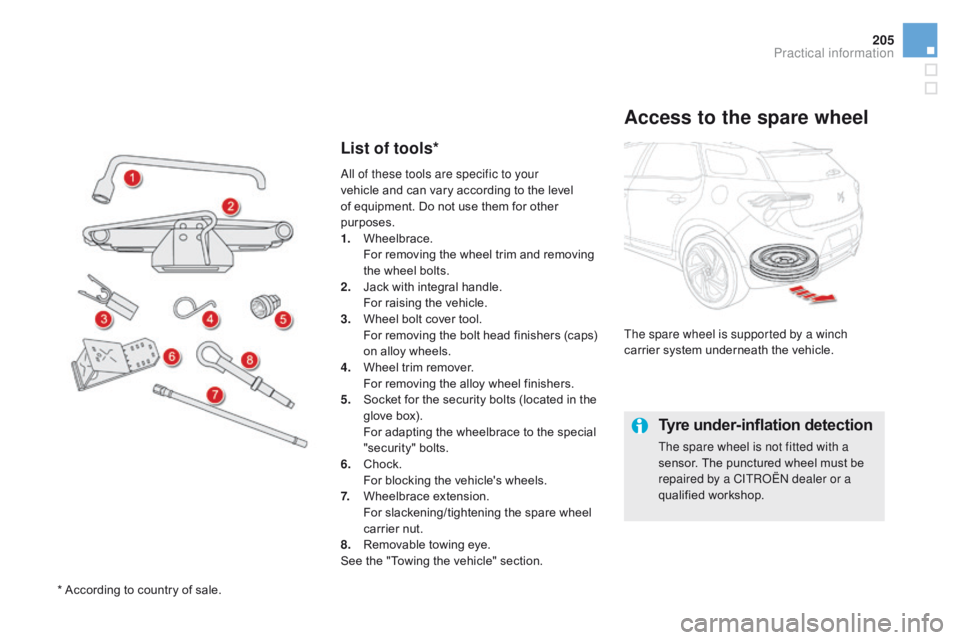
205
DS5_en_Chap08_info-pratiques_ed01-2015
List of tools*
Access to the spare wheel
The spare wheel is supported by a winch
carrier system underneath the vehicle.
Tyre under-inflation detection
The spare wheel is not fitted with a
sensor. The punctured wheel must be
repaired by a CITROËN dealer or a
qualified workshop.
All of these tools are specific to your
vehicle and can vary according to the level
of equipment. Do not use them for other
purposes.
1.
W
heelbrace.
F
or removing the wheel trim and removing
the wheel bolts.
2.
J
ack with integral handle.
F
or raising the vehicle.
3.
W
heel bolt cover tool.
F
or removing the bolt head finishers (caps)
on alloy wheels.
4.
W
heel trim remover.
F
or removing the alloy wheel finishers.
5.
S
ocket for the security bolts (located in the
glove box). F
or adapting the wheelbrace to the special
"security" bolts.
6.
Ch
ock.
F
or blocking the vehicle's wheels.
7.
W
heelbrace extension.
F
or slackening/tightening the spare wheel
carrier nut.
8.
R
emovable towing eye.
See the "Towing the vehicle" section.
* According to country of sale.
Practical information
Page 209 of 403
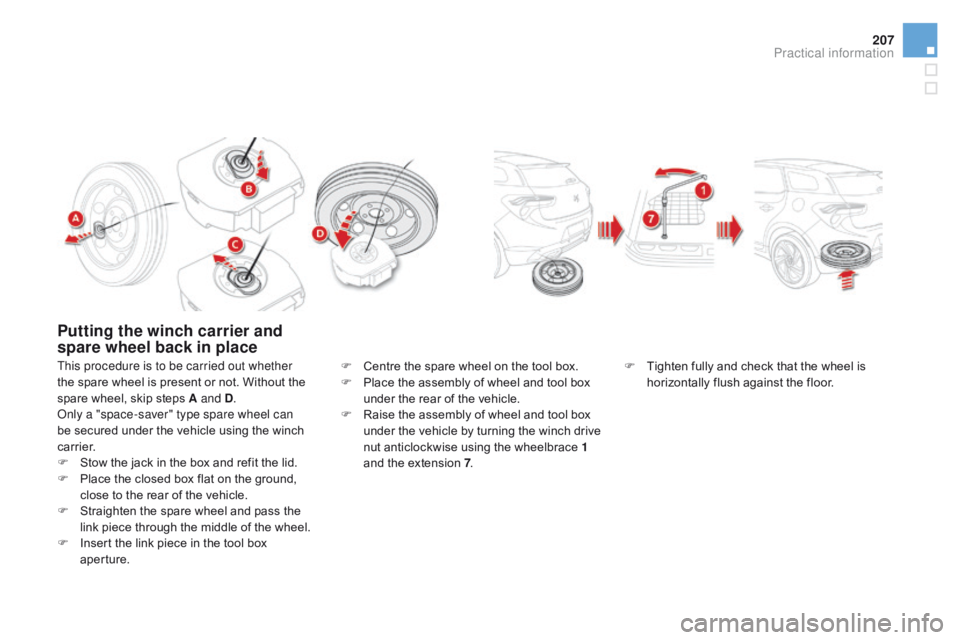
207
DS5_en_Chap08_info-pratiques_ed01-2015
Putting the winch carrier and
spare wheel back in place
This procedure is to be carried out whether
the spare wheel is present or not. Without the
spare wheel, skip steps A and d
.
O
nly a "space-saver" type spare wheel can
be secured under the vehicle using the winch
c a r r i e r.
F
S
tow the jack in the box and refit the lid.
F
P
lace the closed box flat on the ground,
close to the rear of the vehicle.
F
S
traighten the spare wheel and pass the
link piece through the middle of the wheel.
F
I
nsert the link piece in the tool box
aperture. F
C entre the spare wheel on the tool box.
F
P
lace the assembly of wheel and tool box
under the rear of the vehicle.
F
R
aise the assembly of wheel and tool box
under the vehicle by turning the winch drive
nut anticlockwise using the wheelbrace 1
and the extension 7 . F
T ighten fully and check that the wheel is
horizontally flush against the floor.
Practical information
Page 212 of 403
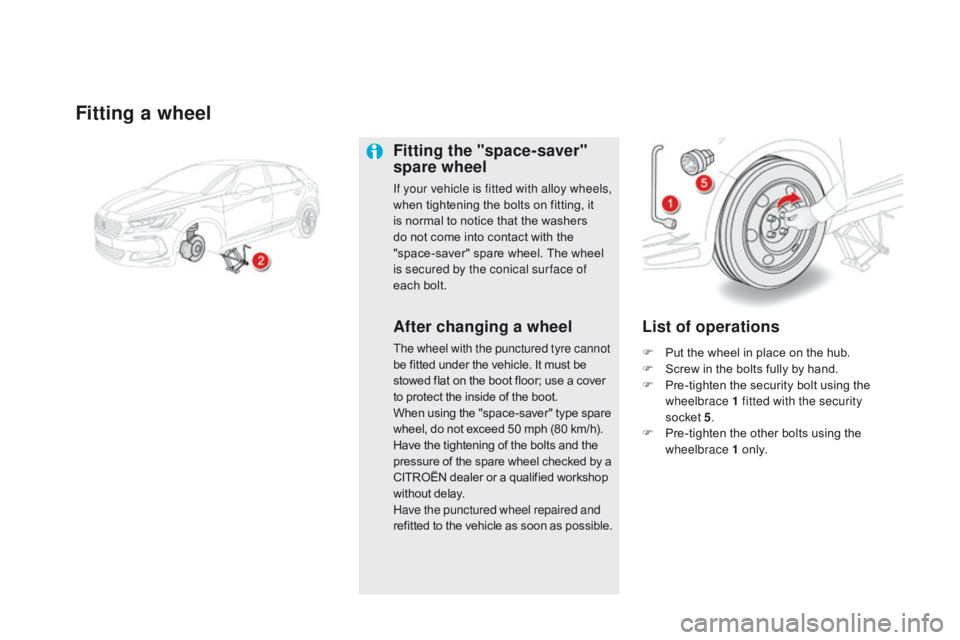
DS5_en_Chap08_info-pratiques_ed01-2015
Fitting a wheel
Fitting the "space-saver"
spare wheel
If your vehicle is fitted with alloy wheels,
when tightening the bolts on fitting, it
is normal to notice that the washers
do not come into contact with the
"space-saver" spare wheel. The wheel
is secured by the conical sur face of
each bolt.
After changing a wheel
The wheel with the punctured tyre cannot
be fitted under the vehicle. It must be
stowed flat on the boot floor; use a cover
to protect the inside of the boot.
When using the "space-saver" type spare
wheel, do not exceed 50 mph (80 km/h).
Have the tightening of the bolts and the
pressure of the spare wheel checked by a
CITROËN dealer or a qualified workshop
without delay.
Have the punctured wheel repaired and
refitted to the vehicle as soon as possible.
List of operations
F Put the wheel in place on the hub.
F S crew in the bolts fully by hand.
F
P
re-tighten the security bolt using the
wheelbrace 1 fitted with the security
socket
5 .
F
P
re-tighten the other bolts using the
wheelbrace 1 o n l y.
Page 216 of 403
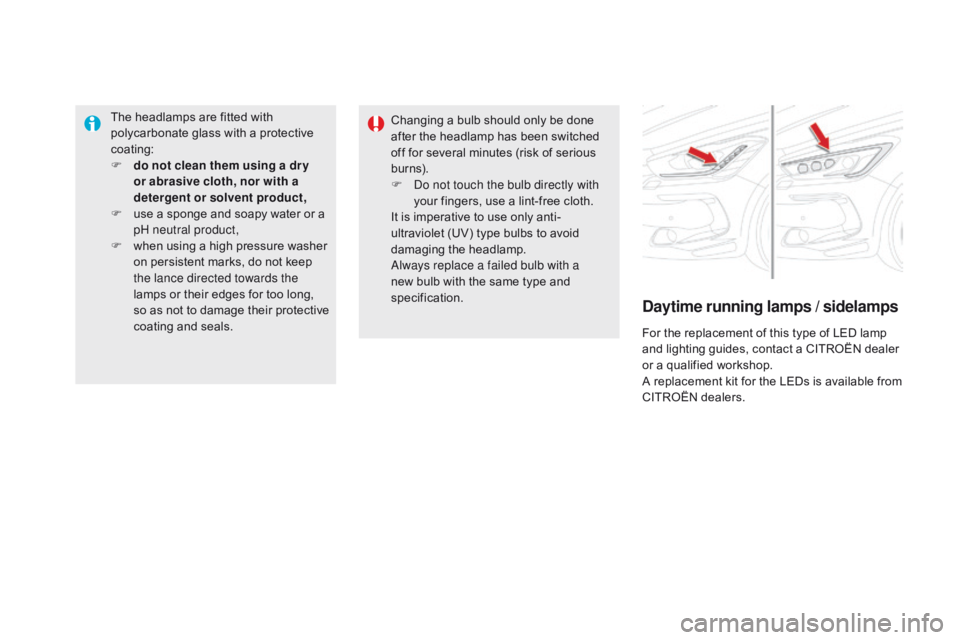
DS5_en_Chap08_info-pratiques_ed01-2015
The headlamps are fitted with
polycarbonate glass with a protective
coating:
F
d
o not clean them using a dr y
or abrasive cloth, nor with a
detergent or solvent product,
F
u
se a sponge and soapy water or a
pH neutral product,
F
w
hen using a high pressure washer
on persistent marks, do not keep
the lance directed towards the
lamps or their edges for too long,
so as not to damage their protective
coating and seals. Changing a bulb should only be done
after the headlamp has been switched
off for several minutes (risk of serious
burns).
F
D
o not touch the bulb directly with
your fingers, use a lint-free cloth.
It is imperative to use only anti-
ultraviolet (UV) type bulbs to avoid
damaging the headlamp.
Always replace a failed bulb with a
new bulb with the same type and
specification.
daytime running lamps / sidelamps
For the replacement of this type of LED lamp
and lighting guides, contact a CITROËN dealer
or a qualified workshop.
A replacement kit for the LEDs is available from
CITROËN dealers.
Page 231 of 403
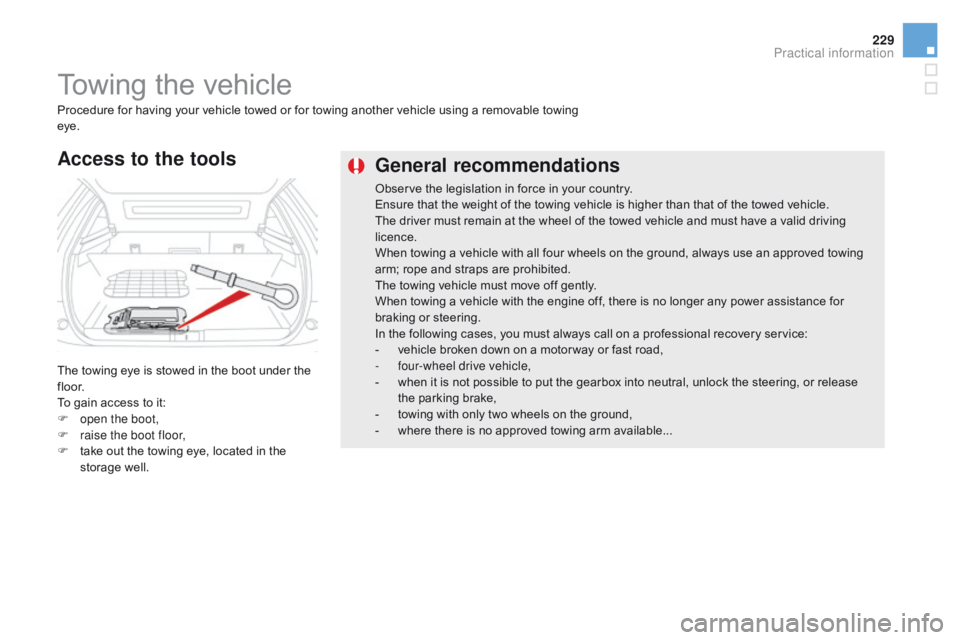
229
DS5_en_Chap08_info-pratiques_ed01-2015
General recommendations
Observe the legislation in force in your country.
Ensure that the weight of the towing vehicle is higher than that of the towed vehicle.
The driver must remain at the wheel of the towed vehicle and must have a valid driving
licence.
When towing a vehicle with all four wheels on the ground, always use an approved towing
arm; rope and straps are prohibited.
The towing vehicle must move off gently.
When towing a vehicle with the engine off, there is no longer any power assistance for
braking or steering.
In the following cases, you must always call on a professional recovery service:
-
v
ehicle broken down on a motor way or fast road,
-
f
our-wheel drive vehicle,
-
w
hen it is not possible to put the gearbox into neutral, unlock the steering, or release
the parking brake,
-
t
owing with only two wheels on the ground,
-
w
here there is no approved towing arm available...
Towing the vehicle
Access to the tools
The towing eye is stowed in the boot under the
f l o o r.
To gain access to it:
F
o
pen the boot,
F
r
aise the boot floor,
F
t
ake out the towing eye, located in the
storage well.
Procedure for having your vehicle towed or for towing another vehicle using a removable towing
eye.
Practical information
Page 232 of 403
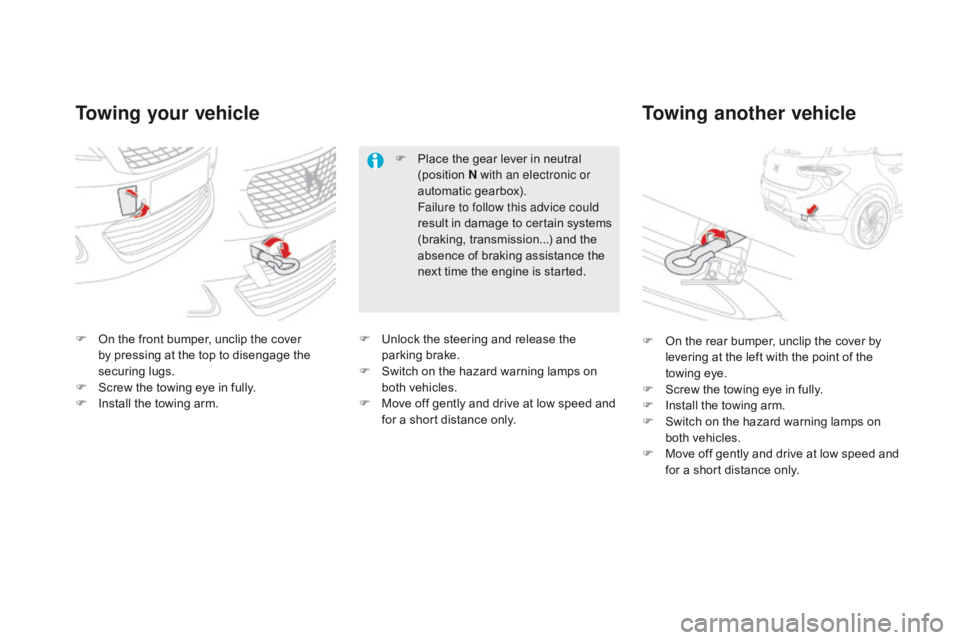
DS5_en_Chap08_info-pratiques_ed01-2015
Towing your vehicleTowing another vehicle
F On the front bumper, unclip the cover
by pressing at the top to disengage the
securing lugs.
F
S
crew the towing eye in fully.
F
I
nstall the towing arm. F
O n the rear bumper, unclip the cover by
levering at the left with the point of the
towing eye.
F
S
crew the towing eye in fully.
F
I
nstall the towing arm.
F
S
witch on the hazard warning lamps on
both vehicles.
F
M
ove off gently and drive at low speed and
for a short distance only.
F
P
lace the gear lever in neutral
(position N with an electronic or
automatic gearbox).
F
ailure to follow this advice could
result in damage to certain systems
(braking, transmission...) and the
absence of braking assistance the
next time the engine is started.
F U nlock the steering and release the
parking brake.
F
S
witch on the hazard warning lamps on
both vehicles.
F
M
ove off gently and drive at low speed and
for a short distance only.
Page 233 of 403
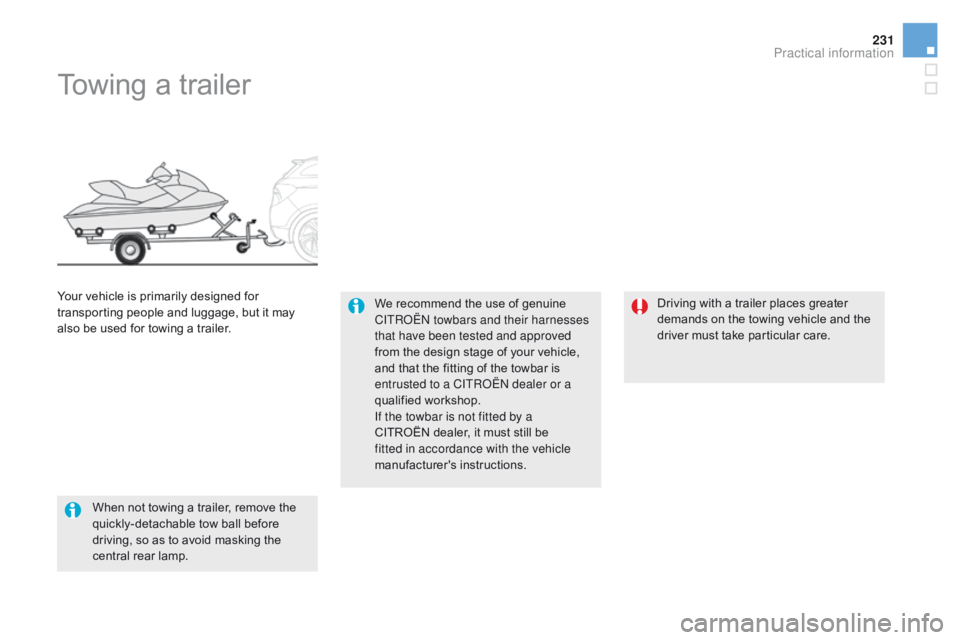
231
DS5_en_Chap08_info-pratiques_ed01-2015
Towing a trailer
We recommend the use of genuine
CITROËN towbars and their harnesses
that have been tested and approved
from the design stage of your vehicle,
and that the fitting of the towbar is
entrusted to a CITROËN dealer or a
qualified workshop.
If the towbar is not fitted by a
CITROËN dealer, it must still be
fitted in accordance with the vehicle
manufacturer's instructions.
Your vehicle is primarily designed for
transporting people and luggage, but it may
also be used for towing a trailer.
When not towing a trailer, remove the
quickly-detachable tow ball before
driving, so as to avoid masking the
central rear lamp. Driving with a trailer places greater
demands on the towing vehicle and the
driver must take particular care.
Practical information
Page 234 of 403
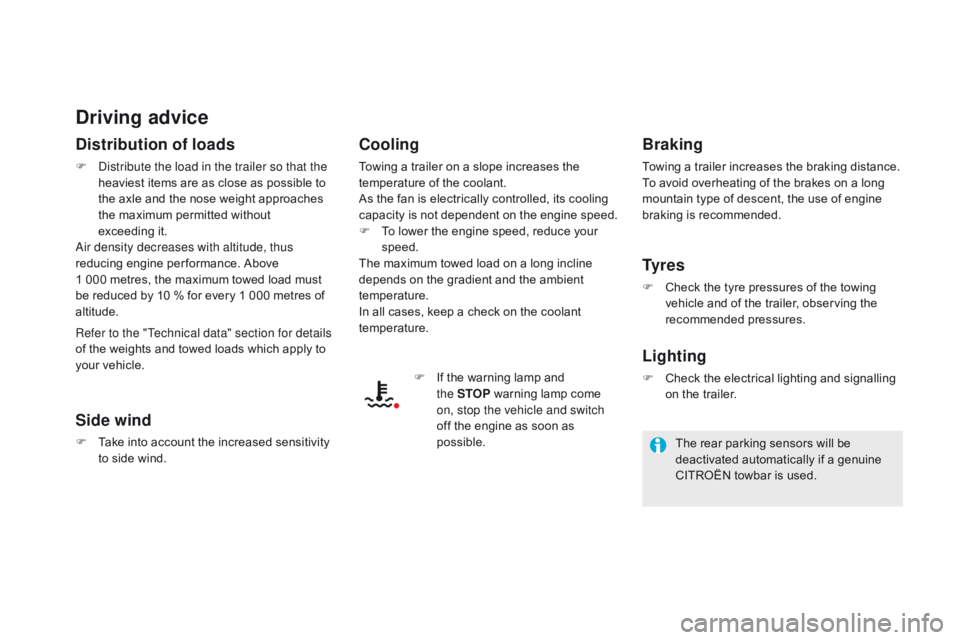
DS5_en_Chap08_info-pratiques_ed01-2015
driving advice
distribution of loads
F Distribute the load in the trailer so that the heaviest items are as close as possible to
the axle and the nose weight approaches
the maximum permitted without
exceeding
it.
Air density decreases with altitude, thus
reducing engine per formance. Above
1
000 metres, the maximum towed load must
be reduced by 10
% for every 1 000 metres of
altitude.
Side wind
F Take into account the increased sensitivity to side wind.
cooling
Towing a trailer on a slope increases the
temperature of the coolant.
As the fan is electrically controlled, its cooling
capacity is not dependent on the engine speed.
F
T
o lower the engine speed, reduce your
speed.
The maximum towed load on a long incline
depends on the gradient and the ambient
temperature.
In all cases, keep a check on the coolant
temperature.
F
I
f the warning lamp and
the
STOP warning lamp come
on, stop the vehicle and switch
off the engine as soon as
possible.
Braking
Towing a trailer increases the braking distance.
To avoid overheating of the brakes on a long
mountain type of descent, the use of engine
braking is recommended.
Ty r e s
F Check the tyre pressures of the towing vehicle and of the trailer, observing the
recommended pressures.
Lighting
F Check the electrical lighting and signalling on the trailer.
Refer to the "Technical data" section for details
of the weights and towed loads which apply to
your vehicle.
The rear parking sensors will be
deactivated automatically if a genuine
CITROËN towbar is used.
Page 237 of 403
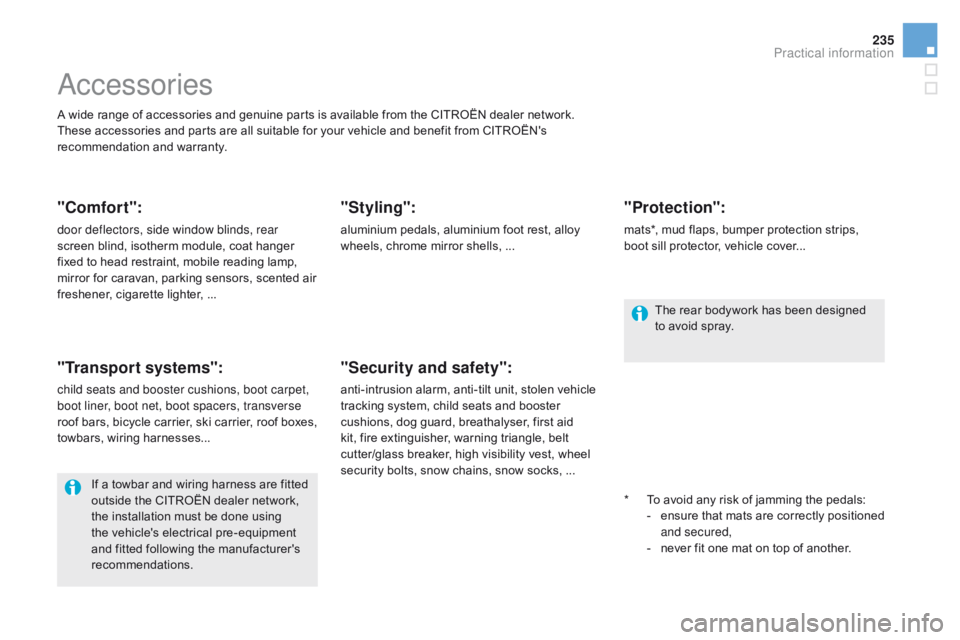
235
DS5_en_Chap08_info-pratiques_ed01-2015
Accessories
A wide range of accessories and genuine parts is available from the CITROËN dealer network.
These accessories and parts are all suitable for your vehicle and benefit from CITROËN's
recommendation and warranty.
"comfort":
door deflectors, side window blinds, rear
screen blind, isotherm module, coat hanger
fixed to head restraint, mobile reading lamp,
mirror for caravan, parking sensors, scented air
freshener, cigarette lighter, ...
"Transport systems":
child seats and booster cushions, boot carpet,
boot liner, boot net, boot spacers, transverse
roof bars, bicycle carrier, ski carrier, roof boxes,
towbars, wiring harnesses...
"Styling":
aluminium pedals, aluminium foot rest, alloy
wheels, chrome mirror shells, ...*
T
o avoid any risk of jamming the pedals:
-
e
nsure that mats are correctly positioned
and secured,
-
n
ever fit one mat on top of another.
"Security and safety":
anti-intrusion alarm, anti-tilt unit, stolen vehicle
tracking system, child seats and booster
cushions, dog guard, breathalyser, first aid
kit, fire extinguisher, warning triangle, belt
cutter/glass breaker, high visibility vest, wheel
security bolts, snow chains, snow socks, ...
"Protection":
mats*, mud flaps, bumper protection strips,
boot sill protector, vehicle cover...
If a towbar and wiring harness are fitted
outside the CITROËN dealer network,
the installation must be done using
the vehicle's electrical pre-equipment
and fitted following the manufacturer's
recommendations. The rear bodywork has been designed
to avoid spray.
Practical information